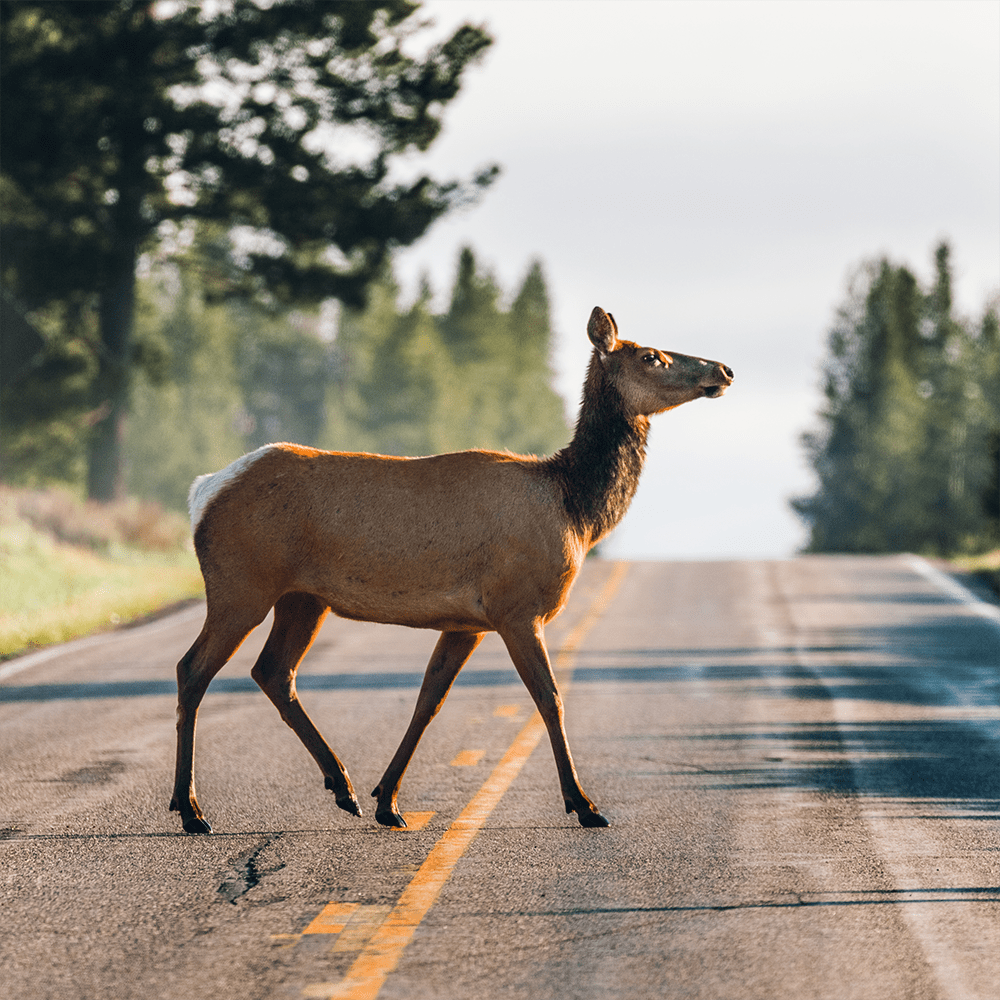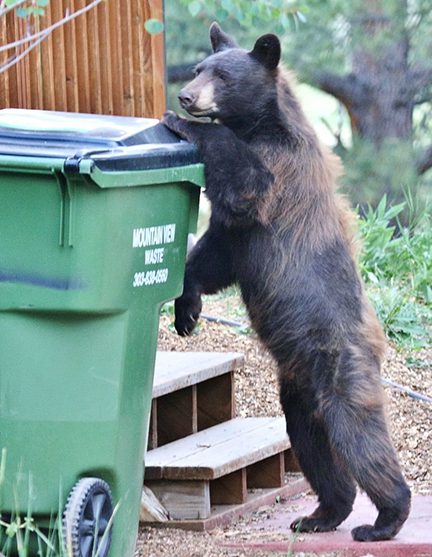
Let’s just get to the punchline: The elk crossed the road because she lives here, and she lived here first, at that. She crosses the road whenever she damn well pleases, regal and commanding, and sir, you best stop, stare and admire her.
“Seeing a hurt or endangered animal is an emotional experience.”
Christie Greene, founder of Wild Aware, agrees. “It is a special thing to have to stop and watch them. It’s awesome,” she says. “They wander, they mosey. You’ll get the one female who will go out and make sure everything is good. Stand there, nurse. It’s a joy of living here.”
It’s the heart of summertime in the mountains, and what would it be without tourist attacks? You may think I mean the descent of daytrippers into our community, but that’s a rant for a different day because today I’m talking about the so-called “attacks” on tourists, á la the wildlife. Just the other day, I witnessed a woman struggling back over the barriers around the lake trail, tangled up in her dogs’ leashes, dropping her cell phone (probably with the camera on), as she ran, terrified, away from a mother elk. It’s a funny anecdote if I meet you for drinks, but in reality, it’s a serious issue—and becoming a bigger one, which the nonprofit, Wild Aware, is hoping to address.
“We have trained volunteers who go down to the lake and talk to people about wildlife,” she explains. “We are trying to help people understand what’s going on with the mama elk and the babies on the island. We’ll say, ‘We recommend that you walk way around her—we point out the calves, and then their eyes pop open, and they learn that the mom is protecting them. A lot of people are respectful if they understand the situation. Which is good because that mom will come at you, she could be to you in one step—she will pound you with her hooves.”
Unfortunately, as the mountain area welcomes new residents and the community shifts, it’s not only a tourist issue anymore. There are an increasing number of dangerous wildlife encounters, resulting in both human and animal injuries or death. There is a lack of awareness or care toward the wildness of animals, the relationship between humans and nature and, most importantly, what to do in an unexpected wildlife situation, especially if the animal is in need of assistance.
Part of this, Greene explains, is an educational issue. Seeing a hurt or endangered animal is an emotional experience. “It’s heartbreaking. But the best thing you can do is call, *277,” she says.

Photo by Jackie Crivello

Video screen grab by Jackie Crivello
The *277 number is actually the dispatch line for the Colorado State Patrol, but so is it the designated number for wildlife emergencies. This number is not for wildlife sightings, but for situations where action is required—for example, a deer trapped on a fence, a bear stuck in a car, or other scenarios where an animal needs to be freed or removed from public property. Just like calling 911, which dispatches the closest and best-suited first responders to the scene, dialing *277 in wildlife emergencies is the fastest way to get the proper trained professionals to an animal in need.
Sharing this important information is part of the reason Wild Aware began. “We would see posts on social media, people encountering animals and not knowing what to do,” and so began the awareness campaign for the first order of business.
“They take your information and details about the situation, and then make the appropriate decisions based on time of day and who’s in the area,” Greene explains. And after that? “Just try to hold people back and give the animal space.”
But sometimes these devastating animal encounters have had less to do with a lack of education, and more to do with an unwillingness to adjust a lifestyle out of respect for wildlife and our cohabitation. When Wild Aware launched in 2019, the true catalyst had been an elk collision on Hwy 74.
We’ve all used the excuse, “Sorry I’m late. Elk traffic jam,” which I always thought was endearing and comical. Apparently, not everyone feels the same way. This summer alone, I’ve watched drivers honk their horns, drive through the elk herd, and even bump the elk with their cars.
“Which is illegal,” Greene says. “We like to remind people that if one animal comes out on the road, there might be another one coming. So, slow down or stop. Don’t honk or haze them off the road. Don’t get out of your car to shoo them off the road. They’re unpredictable. And elk don’t understand something that travels 60 MPH. So, slow down, blink your lights or use flashers to warn other drivers, stop if you have to.”
In an effort to share the only real solution, which I will comment here is just patience, and a basic respect for Creation, Wild Aware has worked with the Colorado Department of Transportation (CDOT) to install signs along the highway, which will soon be made permanent. But more than that, the organization hopes to infuse the community with a sense of peaceful collaboration, not just when it comes to elk encounters, but in living with other wildlife as well.

“Our mission is to try to help our community coexist with wildlife. We’re so blessed with a resident elk herd that moves around with impunity—they don’t have any fear of us,” Greene says. “We also have bears breaking into people’s trash or their homes or cars—and they don’t come out on the good end. There are birds, baby fawns—” and Wild Aware has advice on how to live day-to-day, harmoniously among all of these species.
Often, the message is create distance, live and let live. “Give them space and respect. Let them be the wild animals that they are. Just let them be,” says Greene.
“We are trying to help people understand what’s going on with the mama elk and the babies on the island.”

This includes taking photos. In the age of Instagram and Facebook, the greatest consequences are often a result of “doing it for the ’gram.” Jackie Crivello, local wildlife photographer, knows this all too well. “When I’m there photographing, I’m keeping my distance, I know where to stand, what could be problematic,” she says. “But people with a cell phone aren’t going to get the shot unless they step up [to the animal]. People need to understand that the photos they see on Facebook or whatever are coming from photographers like myself with very long lenses. I’m not risking my life or the animals’ lives.”
The Wild Aware effort is growing and spreading the word. They will have an informational event on August 11, along with Julia Kintsch from EcoResolutions. These community meetings share best practices for respectfully cohabitating with mountain animals—simple actions, Greene explains. “We put human safety first, but it is on us to do what we need to do so we aren’t causing animals duress and destruction. Bears are a biggie—secure your trash. If the bears lose a fear of people, Parks & Wildlife will have to put them down. Instead of feeders, bring in different kinds of plants that attract pollinators and hummingbirds. Don’t pick up the fawns. The moms might leave them for hours, but they lie still; they don’t have any smell. The DOW will tell you to let them be.”
For more information about Wild Aware or what you should do in a wildlife encounter, visit WildAware.org.
